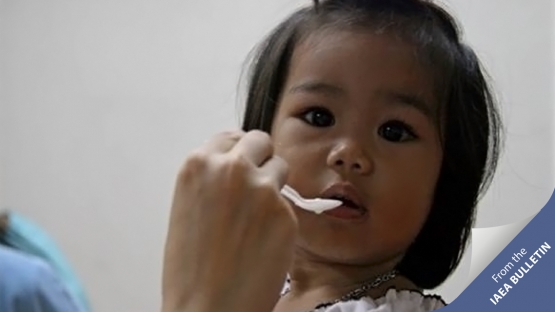Nuclear techniques contribute to Thailand's fight against malnutrition by helping scientists identify best ways to increase nutrient levels in children. Studies carried out since 2009 with the support of the IAEA have shown that food fortified with vitamins and minerals, such as iron, zinc, vitamin A and calcium, enhance micronutrient intake and increase nutrient levels in children.
“There was a micronutrient gap in the diets of these young children, a gap that most local foods cannot meet,” said Emorn Udomkesmalee, Senior Advisor and Former Director of the Institute of Nutrition, Mahidol University (INMU) near Bangkok. “By using isotopic techniques, we found a way to identify this gap and to measure how their bodies absorb and use certain micronutrients.”
Children need more micronutrients for their growth than provided in a typical diet, which contains sufficient calories, but often not enough iron, zinc, vitamin A or calcium. In many developing countries, low nutrient- density food such as plants is a main part of the diet. This can result in micronutrient deficiencies — often referred to as ‘hidden hunger’ — that can affect hundreds of thousands of children, Udomkesmalee said. According to a 2012 survey, approximately 800 000 children under five suffered from undernutrition in Thailand, putting them at risk of micronutrient deficiencies.
“If children don’t consume enough micronutrients, they do not grow properly and can become vulnerable to infectious diseases,” said Christine Slater, nutrition specialist at the IAEA. Over the past two decades, Thailand has actively worked to reduce malnutrition and nutrient deficiencies through health policies and community-based nutrition programmes.
One way to prevent and control micronutrient deficiencies is to distribute food fortified with vitamins and minerals — now a common practice in Thailand. Fortified food is made by adding micronutrients to commonly consumed food, such as oil or cereals, or by biofortification, the process of growing crops with increased levels of these essential micronutrients. This fortified food is typically added as a complement to a normal diet.
Between 2009 and 2012, Thai scientists trained by the IAEA tested a food fortification programme in children between six and 24 months old. They gave a group of children rice fortified with iron, zinc and vitamin A. After measuring their micronutrient reserves using isotopic techniques (see Isotopic techniques and nutrition in children), they found that children who consumed the fortified rice had a significant increase in iron, zinc and vitamin A reserves, in contrast to the control group. They used a computer simulation to further confirm the suitability of the fortified rice for meeting nutrient requirements.
Before the introduction of isotopic techniques, scientists in Thailand had to rely on calculations based on select, high-nutrient food to verify whether the country’s nutrition programmes were working, said Pattanee Winichagoon, Associate Professor at INMU. “Assessment was based on our knowledge and calculations and did not adequately consider elements such as the body’s absorption of the micronutrients,” she said.
Turning data into practice
The results of these studies are now under consideration to help further optimize nutrition intervention programmes across the country.
“We have been communicating with the Ministry of Public Health and the Paediatric Nutrition Group and already started discussions on how to make use of our analyses,” Winichagoon said. If the study results are taken on board, they will lead to new pragmatic feeding guidelines on complementary foods for infants and young children, she added.
Learn today, teach tomorrow
The IAEA has been working with Thailand in the area of nutrition since 1998. The country has benefited from the IAEA’s technical cooperation programme and coordinated research projects in the form of training courses, scientific visits, fellowships and equipment. Thai scientists have also been working with the IAEA to use isotopic techniques to assess exclusive breast-feeding of infants from birth to six months, and to ensure iron-fortified food is not detrimental for people with iron or other nutrient deficiencies.
Hosting courses for others to learn about isotopic techniques is a way to pay these efforts back, Winichagoon said. “It would be a shame not to share the know-how. We have so many questions, and we’re not the only ones.”
Nutrition is a topic of interest for Thailand and for the world, Slater said. “Improved nutrition has great consequences for society. A well-nourished child will have the adequate capacity to study when he or she grows older and will be able to earn a living as an adult. Overall, a well-nourished population helps the country develop.”
There was a micronutrient gap in the diets of these young children, a gap that most local foods cannot meet. By using isotopic techniques, we found a way to identify this gap and to measure how children's bodies absorb and use certain micronutrients.








